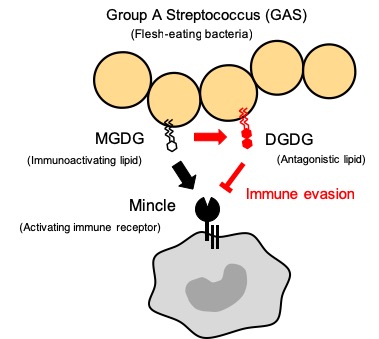Group A <i>Streptococcus<i> converts PAMPs to immunosuppressive lipids to evade host immunity (Yamasaki_Lab, in PNAS)
Group A Streptococcus (GAS) is a Gram-positive bacterial pathogen that causes a range of diseases, including fatal invasive infections. Thus, GAS is also known as “killer bacteria” or “flesh-eating bacteria. However, the mechanisms by which the innate immune system recognizes GAS are not well understood. We herein report that the C-type lectin receptor macrophage inducible C-type lectin (Mincle) recognizes GAS and initiates antibacterial immunity. Gene expression analysis of myeloid cells upon GAS stimulation revealed the contribution of the caspase recruitment domain-containing protein 9 (CARD9) pathway to the antibacterial responses. Among receptors signaling through CARD9, Mincle induced the production of inflam- matory cytokines, inducible nitric oxide synthase, and reactive oxygen species upon recognition of the anchor of lipoteichoic acid, monoglucosyldiacylglycerol (MGDG), produced by GAS. Upon GAS infection, Mincle-deficient mice exhibited impaired production of proinflammatory cytokines, severe bacteremia, and rapid lethality. GAS also possesses another Mincle ligand, diglucosyldiacylglycerol; however, this glycolipid interfered with MGDG-induced activation. These results indicate that Mincle plays a central role in protective immunity against acute GAS infection.
This article is published online in Proceedings of the National Academy of Sciences USA on Oct. 22, 2018.
“Lipoteichoic acid anchor triggers Mincle to drive protective immunity against invasive group A Streptococcus infection”
Imai T, Matsumura T, Sabine Mayer-Lambertz S, Wells C, Ishikawa E, Butcher SK, Barnett TC, Walker MJ, Imamura A, Ishida H, Ikebe T, Miyamoto T, Ato M, Ohga S, Bernd Lepenies, van Sorge NM, Yamasaki S.
Links
- Home
- Achievement
- Research Activities
- Group A <i>Streptococcus<i> converts PAMPs to immunosuppressive lipids to evade host immunity (Yamasaki_Lab, in PNAS)








